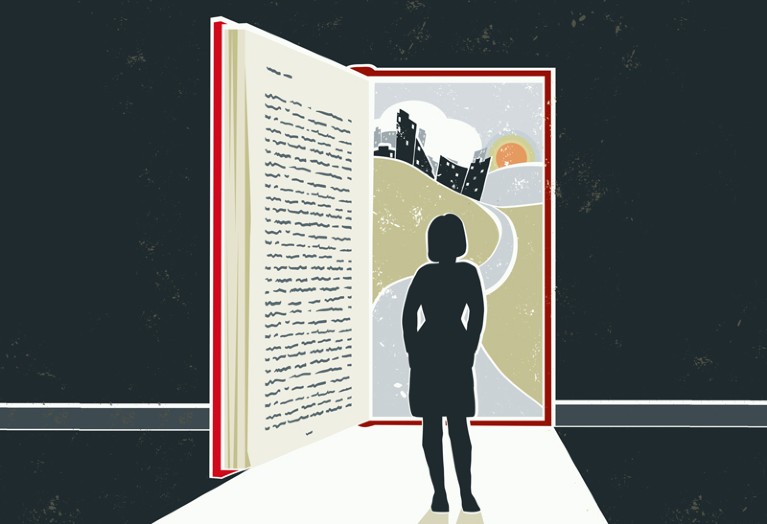week 1: two cultures
The notion of Two Cultures has been especially prominent throughout my time in education. I have always loved writing and I have always loved science; however, these practices have consistently been connoted as opposites. Because of this, I have always felt a tug-of-war between choosing the arts and choosing the sciences. This has led me to Anthropology, for its four disciples act as bridges between the two. Nonetheless, sometimes I still feel as though it is impossible to connect the two worlds considering the ways in which curriculums here always seem to favor one or the other–which, more often than not, happens to be the sciences. Consequently, I feel as though I have been forced to sideline my pursuit in art.
 Image depicting split brain, dividing Science and Art (Beadle 2020). |
That being said, I enjoyed learning about C.P. Snow’s work regarding the notion of Two Cultures. This notion is based on the polarity between the arts and sciences—which is manifested in the overarching understanding of knowledge and how learning is divided (Snow 1959). What especially resonated was the role of the education system in perpetuating the divide (Vesna, Two Cultures PT 2 6:48). The out-dated education system focuses on standardization, producing individuals that regurgitate ideologies that arose from conceptions founded during the enlightenment and industrial revolution (RSA Animates). This contributes to the Two Culture divide because it fails to include contemporary progress regarding technology, and, thus, further divides sectors of education, rather than viewing education as all encompassing. This is harmful because it prevents students from experiencing education in a dynamic form, and it prevents them from developing a sense of individuality.
Dylan Garity performing "Rigged Game" at NPS in Boston, MA (Garity 2013).
It is critical to understand the ways in which the Two Culture divide has stigmatized both sides. As a result of stereotypes, both sides are portrayed based on fictitious extremes; science representation is riddled with caricatures of the “mad scientist” and literary representation is overwhelmed by ideas of the “tortured artist” (Vesna, Two Cultures PT 2 4:57). These stereotypes contribute to discrediting each group; however, these groups must engage in a relationship “based on mutual respect and dialogue” in an effort to bridge a sense of connection (Vesna, Toward a Third Culture 122). This is especially true because–at the end of the day–these fields share a “need to discover and create something new that is whole and total, harmonious and beautiful” (Bohm 138).

Image depicting a figure discovering an environment in a book (Niehaus 2018)
Works Cited
Bohm, D. “On Creativity.” Leonardo, vol. 1, no. 2, 1968, pp. 137–49. JSTOR, https://doi.org/10.2307/1571951. Accessed 7 Apr. 2023.
“RSA Animate: Changing Education Paradigms.” YouTube, YouTube, 14 Oct. 2010, https://www.youtube.com/watch?v=zDZFcDGpL4U&embeds_euri=https%3A%2F%2Fbruinlearn.ucla.edu%2Fcourses%2F160989%2Fpages%2Fweek-1-lectures%3Fmodule_item_id%3D5946318&feature=emb_logo.
Snow, C.P. "The Two Cultures and the Scientific Revolution." Cambridge University Press, 1959.
Vesna, Victoria. “Toward a Third Culture: Being in Between.” Leonardo, vol. 34, no. 2, 2001, pp. 121–25. JSTOR, http://www.jstor.org/stable/1577014. Accessed 7 Apr. 2023.
Vesna, Victoria. “Two Cultures PT2.” YouTube, YouTube, 31 Mar. 2012,
https://www.youtube.com/watch?v=GUr4xxZ_0gw.Garity, Dylan. “Rigged Game.” YouTube, YouTube, 5 Sept. 2013, https://www.youtube.com/watch?v=bo3KFUzyMUI.
Niehaus, Amanda C. “Write Fiction to Discover Something New in Your Research.” Nature News, Nature Publishing Group, 9 May 2018, https://www.nature.com/articles/d41586-018-05089-x.
I am so sorry Cindy, I tried to edit the font after publishing but it did not let me :(
ReplyDeleteI learned a lot through your blog!! Every section, picture, and video really kept me engaged throughout the whole blog!!! Good Job!!!
ReplyDelete